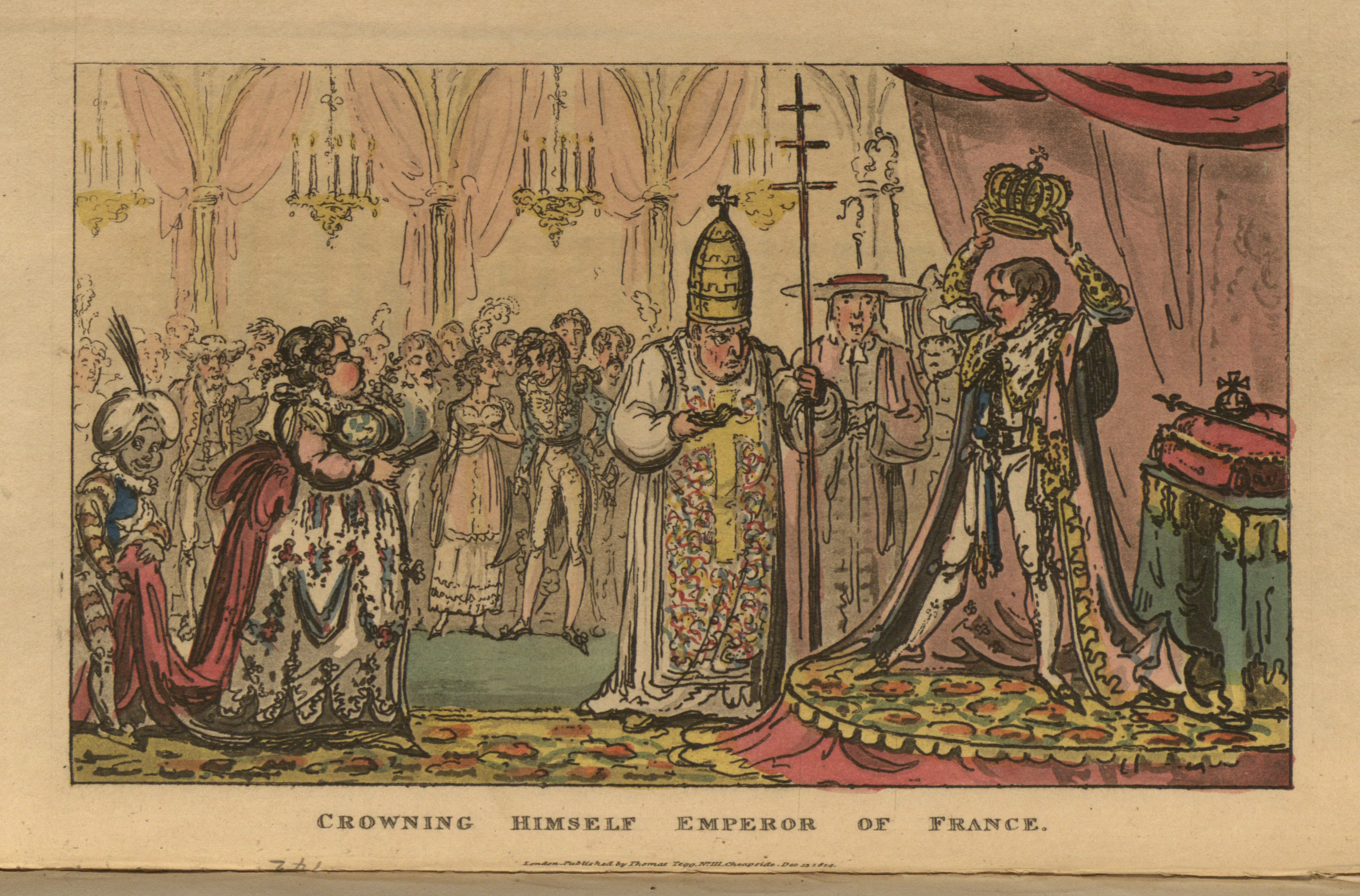Exhibit
Creation Date
13 December 1814
Height
11 cm
Width
19 cm
Medium
Genre
Description
This image depicts the coronation of Napoleon at Notre Dame. Signifying the controversial nature of his rise to power, Napoleon crowns himself rather than being symbolically invested by the collective will of the nation.
Pope Pius VII, decked in religious garb, stands at the forefront of this image. To his left is Napoleon who is depicted standing on a platform as he places a crown upon his head. To the pope’s right is Napoleon’s wife, Josephine. Unlike the other images in the book, Napoleon is not in his military uniform. Rather, he is wearing an elaborate blue robe with blue trim that trails onto the floor. Behind the three is a crowd of people, all formally dressed. Only one member of the audience is a woman. The room, like its inhabitants, is elaborately dressed. Red curtains adorn the Greco-Roman arches and golden chandeliers hang from them.
This image, more than any other in the book, utilizes the grotesque. Napoleon’s height is shortened to a ludicrous size while Josephine is depicted as far more buxom than she actually was. Furthermore, the depiction of the Pope as overweight is ironic, as gluttony is one of the seven deadly sins. It is not surprising that Cruikshank’s portrayal of the Pope is harsh, as he was a supporter of the Church of England.
Not everyone was pleased with Napoleon’s sudden rise to power. Many were fearful of his consolidation of influence. Moreover, it posed great difficulties for the Bonaparte family. Without a son of his own, Napoleon struggled to find an heir. He had, with the aid of his colleagues, deemed both his brothers unfit to take the throne. However, on the day of his coronation they sat on either side of him. The actual coronation occurred at Notre Dame, and in order to provide room for his many important guests Napoleon suggested that houses in the surrounding vicinity be knocked down (R. Asprey, Rise and Fall 270).
The function of this image is blatant, political caricature. The use of the word “himself” in the caption reveals that the crowning of Napoleon was not a collective decision. Napoleon is situated on a platform to exaggerate his miniscule height, and his wife, Josephine, is depicted as grossly overweight.
Like Gillray, who “Treated pictorially [Napoleon and Josephine] with the grossest possible injustice,” Cruikshank also grossly exaggerates their likeness (Jerrold, Life of George Cruikshank 59-60). He “Caricatured the fashions with grotesque exaggeration, both of garments male and female, as well as of faces and figures” (B. Jerrold, Life of George Cruikshank 66). Josephine’s weight is grossly exaggerated, which in turn greatly emphasizes her feminine attributes. This depiction is ironic: Josephine was criticized for her alleged promiscuity, and promiscuity was considered to be the antithesis of ideal femininity. Conversely, the characteristics typical of men are diminished in Napoleon’s depiction, and his height and weight are grossly misrepresented. Much like Josephine's grotesque transformation, Napoleon's own appearance is changed for ironic purposes:this short, skinny man is “crowning himself” Emperor of what was considered the most powerful country in Europe at the time.
Locations Description
The Catholic Church is clearly an organization associated with this image. Due to his immense power at this point in his career, Napoleon was able to single-handedly convince the Pope to officiate his crowning as emperor.
Publisher
Thomas Tegg
Collection
Accession Number
CA 8938
Additional Information
Bibliography
Asprey, Robert. The Rise and Fall of Napoleon Bonaparte. New York: Basic Books, 2000.
Combe, William. The Life of Napoleon: A Hudibrastic Poem in Fifteen Cantos. London: T. Tegg III, 1815.
Jerrold, Blanchard. The Life of George Cruikshank: In Two Epochs. London: Chatto & Windus, 1894.

